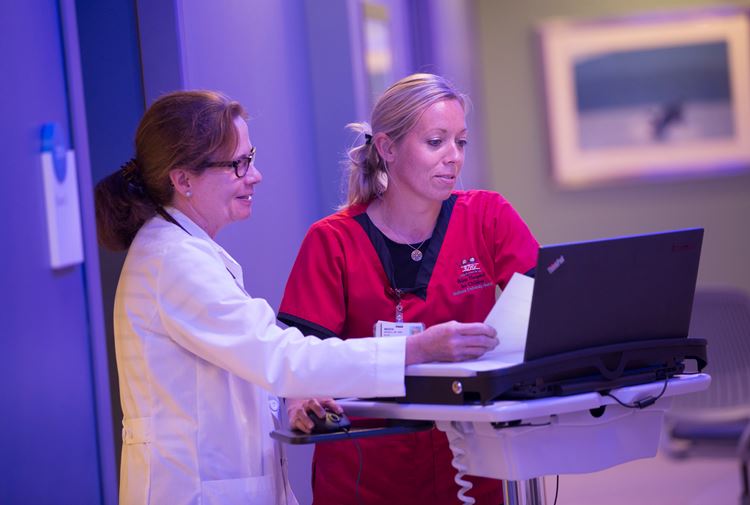When Michelle Howenstine, MD, mentors junior colleagues who are just beginning their careers in medicine, she emphasizes the importance of hard work, excellence and cultivation of core values.
The steps toward leadership in medicine go something like this:
- Begin by focusing on becoming accomplished in your clinical, research or educational area.
- Engage in professional development and continued learning opportunities.
- Cultivate your core values, and know the importance of integrating these values into each decision you make as an emerging leader.
Howenstine knows a bit about growing in leadership. At Indiana University School of Medicine, she leads both Graduate Medical Education (GME) for residents and fellows, as well as Continuing Medical Education (CME) for physicians, nurses, pharmacists and other health care professionals.
The four core values she’s personally identified to help guide her decision-making are truthfulness, integrity, humanism and patience.
“My approach to decisions has to line up with those four areas: Am I being truthful? Is it being done from a place of integrity? Am I thinking of this individual in a humanistic way?” Howenstine said. “If you reflect on those points, you’re not going to have indecisiveness or feel poorly about decisions afterwards, even though some decisions are tough.”
Howenstine is a three-time recipient of the Indiana University Trustees’ Teaching Award.
“The first part of the role of a teacher is to inspire. If you can get though that part, your teaching skills don’t have to be perfect,” she said. “To see someone like the subject is inspiring to both parties.”
Additionally, Howenstine was honored with IU’s prestigious W. George Pinnell Award for Outstanding Service in 2015.
“That award meant so much to me because it encompassed the clinical, teaching and research—it put it all together,” Howenstine said of her multifaceted career at IU.

In the field of cystic fibrosis, Howenstine is considered a national expert, having been awarded over 85 research grants and fellowships and authoring numerous scholarly publications. Before taking on her current leadership roles in GME and CME, Howenstine was center director for the IU Pediatric Cystic Fibrosis Center and program director for IU School of Medicine’s pediatric pulmonology fellowship training program. She still spends a quarter of her time treating patients in the clinical environment.
“The kids instantly win your heart, and it is easy to feel that it is a privilege to care for them,” Howenstine said.
About 10 years ago, Howenstine was involved in clinical research to determine dosages for drugs that had been proven to help patients with CF. Her pediatric patients today look much healthier than the ones who first endeared her in the early days of her medical career.
“It is a really exciting time. The drug trials we did a decade ago are now medications that have been in place for several years in pediatrics, down to the youngest children,” Howenstine said. “Cystic fibrosis is a totally different disease than when I met it as a resident and intern. Babies started on medications early look like ‘Gerber babies’—they look wonderful!”
In many ways, Howenstine exemplifies the excellence of IU School of Medicine’s medical training. After earning her bachelor’s degree in biological sciences from Indiana University, she earned her medical degree from IU School of Medicine and completed a residency in pediatrics, followed by a fellowship in pediatric pulmonology at Riley Hospital for Children at IU Health.
She spent the next 12 years in St. Petersburg, Florida, as chief of the pediatric pulmonary section at All Children’s Hospital, before returning “home” to IU School of Medicine.
“I always say that my heart never left Riley,” Howenstine said. “In Florida, I was able to appreciate how strong my medical school training and pediatric training was. Morris Green, MD, was the chair of pediatrics during my training, and he emphasized family-centered care and the importance of the team in providing the best care. He was truly decades ahead of others in his thinking.”
Now, as a leader in education, Howenstine incorporates the best of what she has learned from Morris and other mentors. This includes building trust and inviting discussions that lead to collaborative solutions.
“I believe a senior leader needs to have a toolbox of skills when handling situations,” she said. “Overall, if one is making decisions from a place aligning with your core values, the outcome will be improved.”
In both Graduate Medical Education and Continuing Medical Education, Howenstine said her team’s most significant accomplishments have been creating innovative projects and development opportunities that are not directly linked to accreditation requirements. In GME, this has included building strong resident and fellow leadership groups and implementing town halls for exchanging information and ideas.
“Dr. Howenstine has developed a unique and effective way to create an inclusive process in the governance of the myriad of programs in Graduate Medical Education,” said colleague Bradley Allen, MD, PhD, senior associate dean for Medical Student Education. “Michelle leads by example, with an unflappable, calm and steady, compassionate response.”
Pediatrician Zeina Nabhan, MD, considers Howenstine an inspiration. First acquainted with Howenstine as a physician-educator and cystic fibrosis expert, Nabhan now works closely with her mentor in her new role as assistant dean for Graduate Medical Education.
From Howenstine she has learned several lessons in leadership:
- Patience—particularly the need to reflect before making any big decisions.
- The importance of engaging everyone on the team and asking for their opinion, no matter who they are.
- Taking time both to celebrate successes and to reflect on failures.
“Dr. Howenstine is a leader who inspires,” Nabhan said. “She is confident, humble, and exhibits an extreme sense of calm in the face of chaos.”
